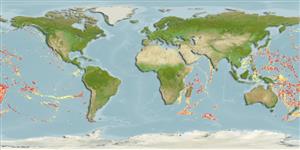Environment: milieu / climate zone / depth range / distribution range
Ökologie
seewasser bathydemersal; tiefenbereich 320 - 2000 m (Ref. 51655). Deep-water
Indo-West Pacific: from Tanzania, Comoros, Madagascar, to Samoa, Moluccas, Marquesas and New Guinea (Ref 9788); north to Taiwan (Ref. 129007),
Size / Gewicht / Alter
Maturity: Lm ? range ? - ? cm
Max length : 13.0 cm TL Männchen/unbestimmt; (Ref. 9788)
Kurzbeschreibung
Bestimmungsschlüssel | Morphologie | Morphometrie
Rückenflossenstacheln (insgesamt) : 6 - 9; Rückenflossenweichstrahlen (insgesamt) : 8 - 9; Afterflossenstacheln: 3 - 6; Afterflossenweichstrahlen: 7 - 8; Wirbelzahl: 30 - 32.
Mesopelagic, bathy-, and benthopelagic rare species, mostly occurring over continental and island slopes. Distinctive kasidoron larval and pre-juvenile stage in epipelagic waters. Zooplankton pickers, with small crustaceans in stomachs of both pre-juveniles and adults (Ref. 9788). The largest specimen collected from Taiwan (10.3 cm SL) is a mature female with two large ovaries containing many large, loose eggs (c. 0.6-0.7 mm); while three other specimens (9.72-10.1 and 10.07 cm SL) are mature males with well-developed testis (Ref. 129007).
Life cycle and mating behavior
Geschlechtsreife | Fortpflanzung | Ablaichen | Eier | Fecundity | Larven
Paxton, J.R., 1999. Gibberichthyidae. Gibberfishes. p. 2203. In K.E. Carpenter and V.H. Niem (eds.) FAO species identification guide for fishery purposes. The living marine resources of the WCP. Vol. 4. Bony fishes part 2 (Mugilidae to Carangidae). FAO, Rome. (Ref. 9788)
IUCN Rote Liste Status (Ref. 130435: Version 2024-2)
Bedrohung für Menschen
Harmless
Nutzung durch Menschen
Fischereien: nicht kommerziell
Tools
Zusatzinformationen
Download XML
Internet Quellen
Estimates based on models
Preferred temperature (Ref.
123201): 1.7 - 2.5, mean 2.1 °C (based on 25 cells).
Phylogenetic diversity index (Ref.
82804): PD
50 = 1.0000 [Uniqueness, from 0.5 = low to 2.0 = high].
Bayesian length-weight: a=0.01122 (0.00514 - 0.02450), b=3.04 (2.87 - 3.21), in cm total length, based on all LWR estimates for this body shape (Ref.
93245).
Trophic level (Ref.
69278): 3.1 ±0.30 se; based on food items.
Fishing Vulnerability (Ref.
59153): Low vulnerability (10 of 100).
